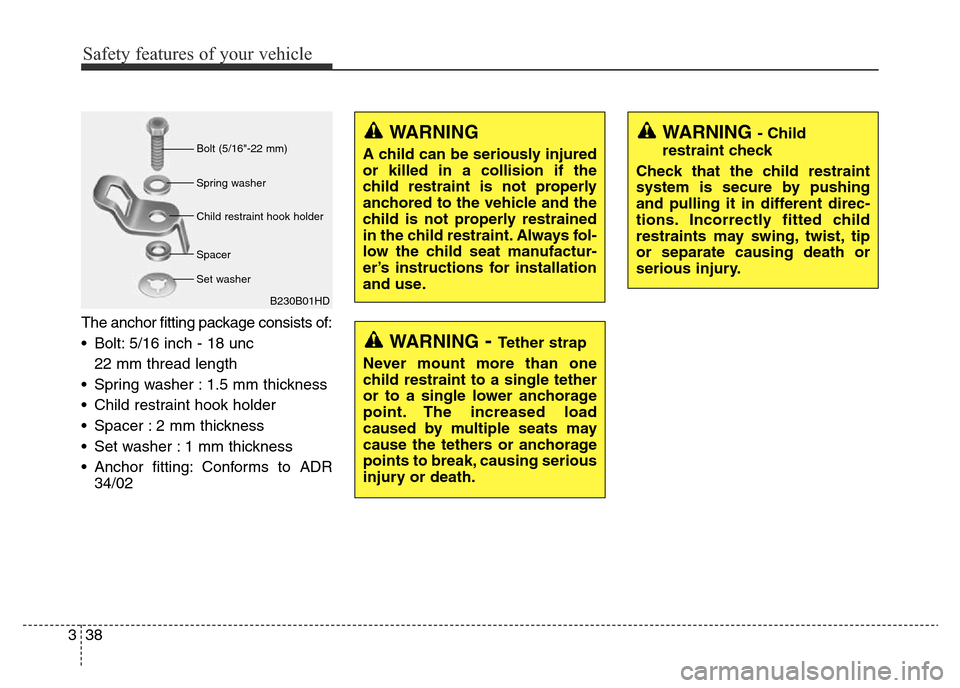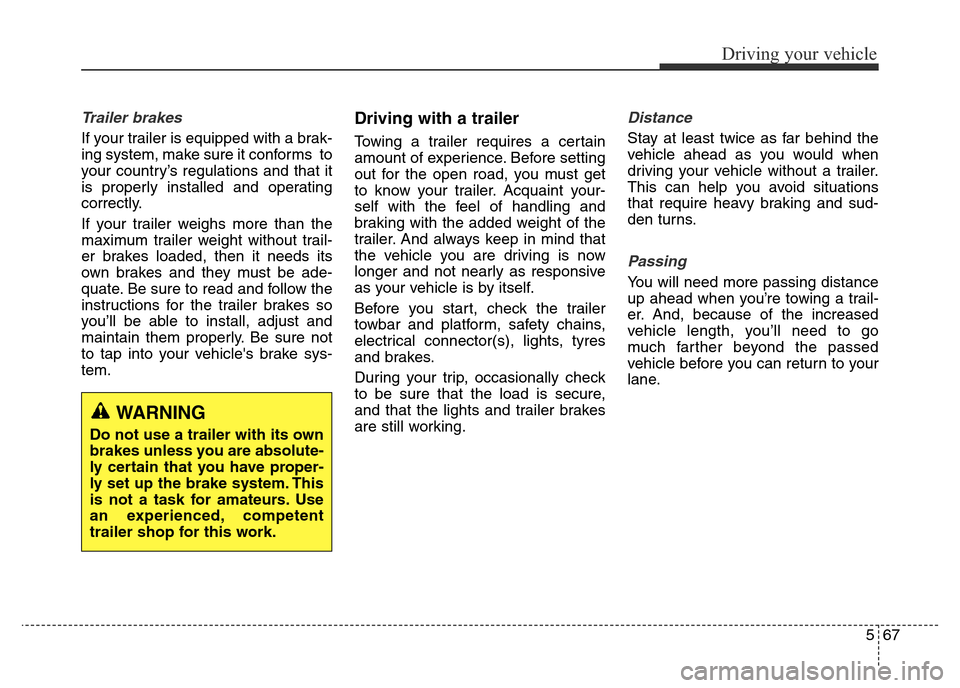Page 41 of 498

323
Safety features of your vehicle
Rear seat (if equipped)
If the ignition switch is turned ON
(engine is not running) when the rear
passenger's seat belt is not fastened,
the corresponding seat belt warning
light will illuminate until the belt is
fastened.And then, the rear corresponding
seat belt warning light will illuminate
for approximately 35 seconds, if any
of the following occurs:
- You start the engine when the rear
belt is not fastened.
- You drive over 9km/h when the rear
belt is not fastened.
- The rear belt is disconnected when
you driver under 20km/h.
If the rear seat belt is fastened, the
warning light will turn off immediately.
If the rear seat belt is disconnected
when you drive over 20km/h, the cor-
responding seat belt warning light
will blink for 35 seconds.
But, if the rear passenger's seat belt
is/are connected and disconnected
twice within 9 seconds after the belt
is fastened, the corresponding seat
belt warning light will not operate.
Lap/shoulder belt
To fasten your seat belt:
To fasten your seat belt, pull it out of
the retractor and insert the metal tab
(1) into the buckle (2). There will be
an audible "click" when the tab locks
into the buckle.
The seat belt automatically adjusts to
the proper length only after the lap
belt portion is adjusted manually so
that it fits snugly around your hips. If
you lean forward in a slow, easy
motion, the seat belt will extend and
let you move around.
OMD031062R
B180A01NF-1/H
Page 55 of 498
337
Safety features of your vehicle
If the child seat moves, readjust the
length of the seat belt. In
Australia/NZ the child restraint man-
ufacturer's instructions must be fol-
lowed when fitting the unit to the
vehicle.Securing a child restraint seat
with “Tether Anchor” system
Child restraint hook holders are
located on the package tray.1.Route the child restraint seat strap
over the seatback.
For vehicles with adjustable head-
rest, route the tether strap under
the headrest and between the
headrest posts, otherwise route
the tether strap over the top of the
seatback.
2.Open the tether anchor cover.
3.Connect the tether strap hook to
the appropriate child restraint hook
holder and tighten to secure the
seat.
OMD030030N
OMD030021N
Page 56 of 498

Safety features of your vehicle
38 3
The anchor fitting package consists of:
• Bolt: 5/16 inch - 18 unc
22 mm thread length
• Spring washer : 1.5 mm thickness
• Child restraint hook holder
• Spacer : 2 mm thickness
• Set washer : 1 mm thickness
• Anchor fitting: Conforms to ADR
34/02
WARNING- Tether strap
Never mount more than one
child restraint to a single tether
or to a single lower anchorage
point. The increased load
caused by multiple seats may
cause the tethers or anchorage
points to break, causing serious
injury or death.
WARNING
A child can be seriously injured
or killed in a collision if the
child restraint is not properly
anchored to the vehicle and the
child is not properly restrained
in the child restraint. Always fol-
low the child seat manufactur-
er’s instructions for installation
and use.
B230B01HD Bolt (5/16"-22 mm)
Spring washer
Child restraint hook holder
Set washer
Spacer
WARNING - Child
restraint check
Check that the child restraint
system is secure by pushing
and pulling it in different direc-
tions. Incorrectly fitted child
restraints may swing, twist, tip
or separate causing death or
serious injury.
Page 371 of 498

567
Driving your vehicle
Trailer brakes
If your trailer is equipped with a brak-
ing system, make sure it conforms to
your country’s regulations and that it
is properly installed and operating
correctly.
If your trailer weighs more than the
maximum trailer weight without trail-
er brakes loaded, then it needs its
own brakes and they must be ade-
quate. Be sure to read and follow the
instructions for the trailer brakes so
you’ll be able to install, adjust and
maintain them properly. Be sure not
to tap into your vehicle's brake sys-
tem.
Driving with a trailer
Towing a trailer requires a certain
amount of experience. Before setting
out for the open road, you must get
to know your trailer. Acquaint your-
self with the feel of handling and
braking with the added weight of the
trailer. And always keep in mind that
the vehicle you are driving is now
longer and not nearly as responsive
as your vehicle is by itself.
Before you start, check the trailer
towbar and platform, safety chains,
electrical connector(s), lights, tyres
and brakes.
During your trip, occasionally check
to be sure that the load is secure,
and that the lights and trailer brakes
are still working.
Distance
Stay at least twice as far behind the
vehicle ahead as you would when
driving your vehicle without a trailer.
This can help you avoid situations
that require heavy braking and sud-
den turns.
Passing
You will need more passing distance
up ahead when you’re towing a trail-
er. And, because of the increased
vehicle length, you’ll need to go
much farther beyond the passed
vehicle before you can return to your
lane.
WARNING
Do not use a trailer with its own
brakes unless you are absolute-
ly certain that you have proper-
ly set up the brake system. This
is not a task for amateurs. Use
an experienced, competent
trailer shop for this work.
Page 491 of 498
Specifications & Consumer information
2 8
ENGINE
DIMENSIONS
Item Petrol 1.8
Displacement
cc1,797
Bore x Stroke
mm81x87.2
Firing order 1-3-4-2
No. of cylinders 4, In-line
Item mm
Overall length 4550
Overall width 1775
Overall height 1435
Front tread 1563 *
1/ 1549 *2 / 1551 *3
Rear tread1576 *1/ 1562 *2 / 1564 *3
Wheelbase2700
*1: with R15 tyre
*
2: with R16 tyre
*
3: with R17 tyre
AIR CONDITIONING SYSTEM
ItemWeight of volume Classification
Refrigerant
500g R134a
Compressor lubricant
100g FD46XG